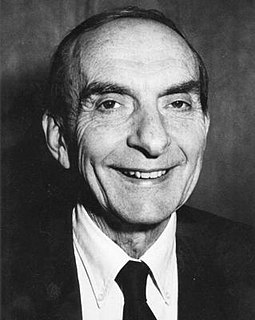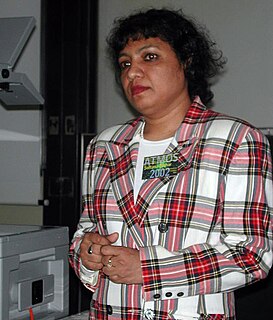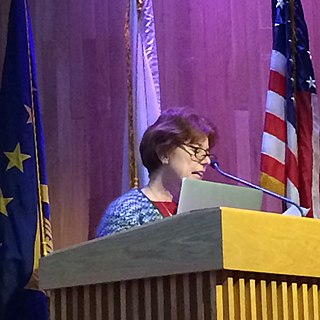Related Research Articles

Janna J. Levin is an American theoretical cosmologist and a professor of physics and astronomy at Barnard College. She earned a Bachelor of Science in astronomy and physics with a concentration in philosophy at Barnard College in 1988 and a PhD in theoretical physics at the Massachusetts Institute of Technology in 1993. Much of her work deals with looking for evidence to support the proposal that our universe might be finite in size due to its having a nontrivial topology. Other work includes black holes and chaos theory. She joined the faculty at Barnard College in January 2004 and is currently the Claire Tow Professor of Physics and Astronomy.
Louise Ann Dolan is an American mathematical physicist and professor of physics at the University of North Carolina at Chapel Hill. She does research in theoretical particle physics, gauge theories, gravity, and string theory, and is generally considered to be one of the foremost experts worldwide in this field. Her work is at the forefront of particle physics today.

Myriam P. Sarachik is an American experimental physicist, and since 1996 is a Distinguished Professor of Physics at The City College of New York. She joined the Physics Department in 1964. Her work is primarily in the field of low temperature condensed matter physics, in which she focuses on molecular nanomagnets and novel phenomena in dilute two-dimensional electron systems.

Gerald Edward Brown was an American theoretical physicist who worked on nuclear physics and astrophysics. Since 1968 he had been a professor at the Stony Brook University. He was a distinguished professor emeritus of the C. N. Yang Institute for Theoretical Physics at Stony Brook University.

Sultana Nurun Nahar is a Bangladeshi-American physicist. She is a research scientist in the Department of Astronomy at Ohio State University.

Barbara Jacak is a nuclear physicist who uses heavy ion collisions for fundamental studies of hot, dense nuclear matter. She is Director of the Nuclear Science Division, Lawrence Berkeley National Laboratory, and a professor of Physics at UC Berkeley. Before going to Berkeley, she was a member of the Department of Physics and Astronomy at Stony Brook University, where she held the rank of Distinguished Professor. She is a leading member of the collaboration that built and operates the PHENIX detector, one of the large detectors that operated at the Relativistic Heavy Ion Collider at Brookhaven National Laboratory, and was involved in the discovery of the quark gluon plasma and its strongly coupled, liquid-like behavior. Throughout her career she has served on many advisory committees and boards including the National Research Council Committee on Nuclear Physics, and the Physical Review C Editorial Board.
Rashmi C. Desai is an Indian-American physicist, professor emeritus of physics at the University of Toronto.
Jacqueline Krim is an American condensed matter physicist specializing in nanotribology, the study of film growth, friction, and wetting of nanoscale surfaces. She is a Distinguished University Professor of Physics at North Carolina State University.
Mildred Widgoff (1924–2004) was an American experimental particle physicist and astroparticle physicist who became the first female faculty member at the Brown University physics department.
Sonia Bacca is an Italian physicist known for her calculations of the interaction forces of small systems of nucleic particles. She is University Professor in Theoretical Physics at the Institute for Nuclear Physics of the University of Mainz in Germany.
Beate Schmittmann is a German condensed matter physicist and academic administrator who works at Iowa State University as dean of the Iowa State University College of Liberal Arts & Sciences. Her research includes work on driven diffusive systems, biomolecular transport, and epidemiology.
Michelle Girvan is an American physicist and network scientist whose research combines methods from dynamical systems, graph theory, and statistical mechanics and applies them to problems including epidemiology, gene regulation, and the study of Information cascades. She is one of the namesakes of the Girvan–Newman algorithm, used to detect community structure in complex systems.
Galina Khitrova was a Russian-American physicist and optical scientist known for her research on cavity quantum electrodynamics, excitons, nonlinear optics, quantum dots, and vacuum Rabi oscillations. She was a professor of optical sciences at the University of Arizona.
Jolie Antonia Cizewski is an American nuclear physicist known for her work on high-mass nuclei, including their symmetries, superdeformation, magic numbers, and the r-process. She is a distinguished professor of physics at Rutgers University.
Ruth Hege Howes is an American nuclear physicist, expert on nuclear weapons, and historian of science, known for her books on women in physics.
Deborah Kay Watson is an American physicist known for her work on the many-body problem in quantum mechanics. She is a professor emerita of physics at the University of Oklahoma.
Karin M. Rabe is an American condensed matter physicist known for her studies of ferroelectric materials, multiferroics, and martensites. She is a distinguished professor and Board of Governors Professor of physics at Rutgers University.
Laura Justine Garwin is an American trumpeter and former science journalist. One of the first women to become a Rhodes Scholar, she is the former physical sciences editor of Nature, co-editor of the book A Century of Nature, and a Fellow of the American Physical Society. After leaving her career in science to become a professional musician in London, she played with the BBC Symphony Orchestra and became principal trumpet of the Covent Garden Sinfonia and the St Paul's Sinfonia.
Paula R. L. Heron is a Canadian-American physics educator who works as a professor of physics at the University of Washington.
Lucy Marie Ziurys is an American astrochemist known for her work on high-resolution molecular spectroscopy. She is Regent's Professor of Chemistry & Biology and of Astronomy at the University of Arizona.
References
- ↑ "Shertzer, Janine 1956–", WorldCat Identities, retrieved 2020-12-07CS1 maint: discouraged parameter (link)
- 1 2 Curriculum vitae (PDF), May 2015, retrieved 2020-12-07CS1 maint: discouraged parameter (link)
- ↑ Theses and dissertations supervised by Frank S. Levin, Brown University Library, retrieved 2020-12-07CS1 maint: discouraged parameter (link)
- 1 2 Holy Cross Physics Professor Receives Distinguished Teaching Award, College of the Holy Cross, October 30, 2015, retrieved 2020-12-07CS1 maint: discouraged parameter (link)
- ↑ APS Fellows Archive: Fellows nominated in 2005 by the APS Topical Group on Few-Body Systems, American Physical Society, retrieved 2020-12-07CS1 maint: discouraged parameter (link)